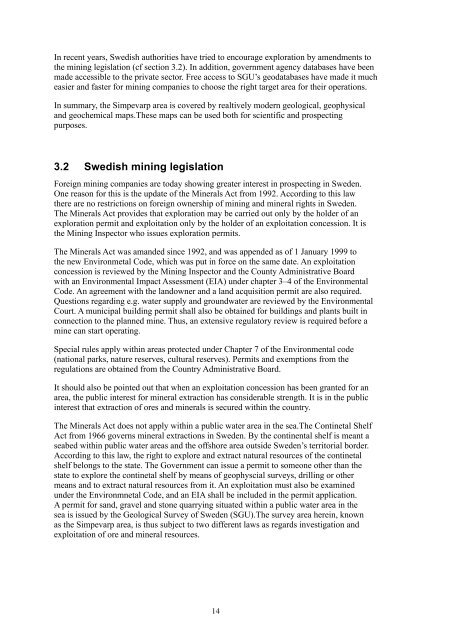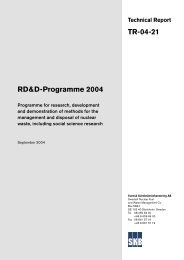Read/Download - SKB
Read/Download - SKB
Read/Download - SKB
You also want an ePaper? Increase the reach of your titles
YUMPU automatically turns print PDFs into web optimized ePapers that Google loves.
In recent years, Swedish authorities have tried to encourage exploration by amendments to<br />
the mining legislation (cf section 3.2). In addition, government agency databases have been<br />
made accessible to the private sector. Free access to SGU’s geodatabases have made it much<br />
easier and faster for mining companies to choose the right target area for their operations.<br />
In summary, the Simpevarp area is covered by realtively modern geological, geophysical<br />
and geochemical maps.These maps can be used both for scientific and prospecting<br />
purposes.<br />
3.2 Swedish mining legislation<br />
Foreign mining companies are today showing greater interest in prospecting in Sweden.<br />
One reason for this is the update of the Minerals Act from 1992. According to this law<br />
there are no restrictions on foreign ownership of mining and mineral rights in Sweden.<br />
The Minerals Act provides that exploration may be carried out only by the holder of an<br />
exploration permit and exploitation only by the holder of an exploitation concession. It is<br />
the Mining Inspector who issues exploration permits.<br />
The Minerals Act was amanded since 1992, and was appended as of 1 January 1999 to<br />
the new Environmetal Code, which was put in force on the same date. An exploitation<br />
concession is reviewed by the Mining Inspector and the County Administrative Board<br />
with an Environmental Impact Assessment (EIA) under chapter 3–4 of the Environmental<br />
Code. An agreement with the landowner and a land acquisition permit are also required.<br />
Questions regarding e.g. water supply and groundwater are reviewed by the Environmental<br />
Court. A municipal building permit shall also be obtained for buildings and plants built in<br />
connection to the planned mine. Thus, an extensive regulatory review is required before a<br />
mine can start operating.<br />
Special rules apply within areas protected under Chapter 7 of the Environmental code<br />
(national parks, nature reserves, cultural reserves). Permits and exemptions from the<br />
regulations are obtained from the Country Administrative Board.<br />
It should also be pointed out that when an exploitation concession has been granted for an<br />
area, the public interest for mineral extraction has considerable strength. It is in the public<br />
interest that extraction of ores and minerals is secured within the country.<br />
The Minerals Act does not apply within a public water area in the sea.The Continetal Shelf<br />
Act from 1966 governs mineral extractions in Sweden. By the continental shelf is meant a<br />
seabed within public water areas and the offshore area outside Sweden’s territorial border.<br />
According to this law, the right to explore and extract natural resources of the continetal<br />
shelf belongs to the state. The Government can issue a permit to someone other than the<br />
state to explore the continetal shelf by means of geophyscial surveys, drilling or other<br />
means and to extract natural resources from it. An exploitation must also be examined<br />
under the Environmnetal Code, and an EIA shall be included in the permit application.<br />
A permit for sand, gravel and stone quarrying situated within a public water area in the<br />
sea is issued by the Geological Survey of Sweden (SGU).The survey area herein, known<br />
as the Simpevarp area, is thus subject to two different laws as regards investigation and<br />
exploitation of ore and mineral resources.<br />
14
















